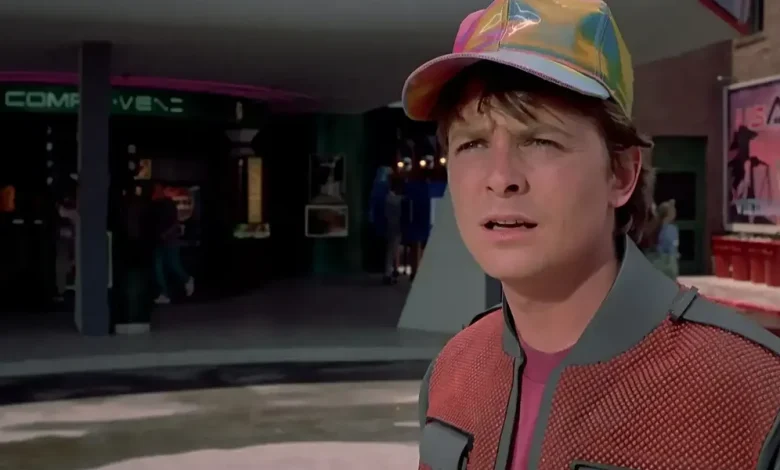11 Modern Tech Gadgets ‘Back to the Future Part II’ Got Exactly Right

Back to the Future Part II deserves credit for getting more right than wrong about our technological future.
In the film, which takes place immediately after the first, Marty McFly (Michael J. Fox) is recruited by Doc Brown (Christopher Lloyd) to “save” Marty’s kids—a mission that requires them to travel to the year 2015 with Marty’s girlfriend, Jennifer (Elisabeth Shue). Going from 1985 to 2015 is a huge shock for Marty, especially when he sees how his future family lives, with technology that might be a little more familiar to viewers of the film today
Sure, the fashion was way off, but it’s rare for a film to ever get that right.
Here are the predictions from Back to the Future Part II that come pretty close to our reality.
Back to the Future Part II Credit: Universal Pictures
Holograms
The film shows Marty getting startled by a holographic shark that appears to leap out from a theater marquee and attack him. It’s advertising for Jaws 19 (a movie that sadly never materialized in our timeline). Directed, of course, by Max Spielberg.
But the holographic marketing concept of the gag is totally feasible. Walk around Tokyo, and you’ll see massive “3D” billboards featuring giant cats, dragons, and other creatures that appear to jump off buildings. Forced perspective is the trick there.
But holograms are completely real, too, and you might have seen one at the airport or the mall. They’re advanced enough now that they can even be interacted with via touch.
Back to the Future Part II Credit: Universal Pictures
Video Calling
The McFly home of 2015 predicted how commonplace it would be to get a video call on a TV screen, as the elder Marty conducts a business meeting via video conference.
Now this is something done daily in boardrooms or even at home when you hop on a Zoom, Google Meet, or FaceTime call. It’s so embedded in our daily lives that it’s easy to forget how revolutionary this prediction was.
Video conferencing exploded during the pandemic, but platforms like Skype and FaceTime had already made it normal years earlier.
Back to the Future Part II Credit: Universal Pictures
Cosmetic Procedures
The film hints at widespread cosmetic enhancement in 2015, suggesting that changing your appearance would become routine and accessible. Doc even took advantage, needing to wear an aging mask to meet Mary because he looked so much younger.
“I went to a rejuvenation clinic,” he says, “and got a whole natural overhaul. They took out some wrinkles, did a hair repair, change of blood. Added a good 30 to 40 years to my life. They also replaced my spleen and colon.”
Cosmetic procedures have exploded in popularity and accessibility. Botox injections, fillers, veneers, buccal fat removal, Brazilian butt lift, laser treatments—you name it, it’s probably commonplace, just like it was in Marty’s world.
Back to the Future Part II Credit: Universal Pictures
Smart Home Technology
When the McFly family enters their home, a Siri-like voice greets them. Simple voice commands control the lights. In the kitchen, a screen called the “Master Cook” displays recipes.
Now Alexa and Google Assistant live in millions of homes. You can program your home to greet you however you want, adjust the temperature, play music, turn on lights via timers or proximity, or lock doors via an app.
If only they had put a screen in the fridge, too.
Back to the Future Part II Credit: Universal Pictures
Self-Lacing Shoes
When Marty McFly puts on those Nike Mags and they automatically tighten around his feet, every kid watching wanted a pair.
Nike eventually made it happen with the Adapt BB line and the Hyperadapt, creating shoes that conformed to the wearer’s foot. Puma also made the AutoDisc. There are other, more affordable options from lesser-known brands.
The technology isn’t quite identical to what’s on screen, but it’s advertised as “self-lacing,” so we’ll call this a win.
Back to the Future Part II Credit: Universal Pictures
Wearable Tech and VR
The kids in 2015 Hill Valley wear glasses that function as personal screens, letting them watch TV and take phone calls without pulling out a separate device. Honestly, the level of screentime Marty Jr. has is enough to make your head spin as he watches, like, six channels at once.
Google Glass attempted this exact concept, though it never caught on with the mainstream. However, VR headsets like the Meta Quest, PlayStation VR2, and Apple Vision Pro have stuck around for a few years, though maybe not to the level of popularity seen in Back to the Future Part II.
Back to the Future Part II Credit: Universal Pictures
Mobile Credit Card Scans
Imagine it. In ye olden days, businesses had to take a physical, paper impression of your credit card to charge it using a machine casually known as a ZipZap machine or click-clack machine. And then the merchant had to keep that paper on file. It’s a positively archaic concept now.
These days, we’re used to using Apple Pay or tapping our cards on a Square reader to initiate a payment, sometimes in the middle of a farmer’s market with no Wi-Fi access or power cords in sight.
Marty has a card reader at his house that he uses, which promptly gets him fired.
Back to the Future Part II Credit: Universal Pictures
Biometrics
At the diner Marty visits at the start of the movie, the AI servers encourage him to pay with his thumb instead of cash. Later, helpful police officers drop Jennifer at “home” and use her thumbprint to get into the house. Shortly after, Biff arrives in a cab and pays for the ride with his thumbprint.
Today, unlocking your phone with your fingerprint or face is pretty normal, and you can definitely use it to get into your house, too. We use biometrics for payments, home security, and identity constantly. So the film was definitely right, here.
Back to the Future Part II Credit: Universal Pictures
Drones
When young Griff is arrested near the start of the film, a drone swoops down and captures footage. That’s all too real for us now, especially around here, where drones are common filmmaking tools.
Later, in the rundown neighborhood of Hilldale, where future Marty lives, there’s a quick sight gag of a dog being walked by a drone. We haven’t gotten there yet, but a small drone might deliver an Amazon package to you instead.
Drones are everywhere. The military uses them. Michael Bay loves them. And you can now buy a personal drone for under $100.
Back to the Future Part II Credit: Universal Pictures
Artificial Intelligence
At Cafe 80s, customers order from AI versions of Ronald Reagan and Michael Jackson. It’s played for laughs in the film, but it looks a bit scary.
AI is everywhere now (still a bit scary), to the point that people have ChatGPT girlfriends. Deepfakes on Sora have stoked fear about likeness usage. Chatbots handle customer service online and via phone.
The film predicted that artificial intelligence would move from science fiction into everyday applications, even if our execution looks different than a fake version of a past president.
Back to the Future Part II Credit: Universal Pictures
Precise Weather Prediction
Doc Brown predicts that rain will stop at a specific moment, and it does. It’s kind of a throwaway moment, but we have similar meteorological tech today that lets us roughly predict how long precipitation will last and where exactly it will fall.
Modern forecasting systems are remarkably accurate, especially in the short term. Doppler radar, satellite imagery, and sophisticated modeling enable meteorologists to track storm systems and precipitation with precision.
What else do you think Back to the Future got right?





